| Guideline And Straight Edge Positions -- Airmail Stamps |
| Scott # |
|
Never Hinged US$ |
Mint Hinged US$ |
Used US$ |
||
| 242971 |
Scott #C1 [1918 6c orange Jenny Biplane] Used with F-VF centering and wavy-lines cancellation. Top guideline example from the 6th horizontal row of stamps in the sheet/pane. The first three airmail stamps, Scott #C1-3, were printed in sheets of 100 and were available at post offices in panes of 100. The plate layout is unusual (and different from C4-6). There is only a single plate number for the sheet, located above column 7; there is no plate number in the left margin. The top and left have perforated sheet margins. The right and bottom margins are not perforated; they have natural straight-edges usually very closely cut to the design of the stamps (no additional sheet margin). There is a vertical guideline between columns 5 and 6 and a horizontal guideline between rows 5 and 6. The guidelines terminate in a marginal arrow at the top and left side. Straight-edge positions quantities: 9 stamps out of every 100-pane had the natural straight edge only on the right; another 9 only on the bottom; and 1 bottom right corner position. Guideline position stamps, depending upon their centering (location of perforations), may or may not share guidelines with the adjacent stamp. Intersection guideline examples (i.e. from a cross-line block) are seldom seen now. Examples with guidelines and especially examples with straight-edges, seem to be scarce, likely due to such stamps either being reperforated or, especially in the case of straight-edge stamps, not being saved by collectors at the time of issue. Examples with straight-edges or guidelines of this stamp were often discarded by early collectors before their significance and relative scarcity was understood. I think that collecting the guideline and straight-edge positions is quite challenging and rewarding. Very attractive with nice color (without the usual oxidation) and perfect perforations. (Scott 2025 value $30 for a normal, more common, example.)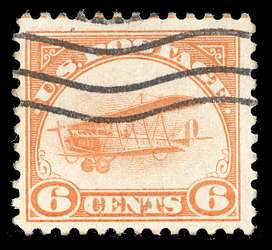 ACTUAL item. |
--- | --- |
20.00 |
||
| 242983 |
Scott #C2 [1918 16c green Jenny Biplane] Used with Fine centering and neat #2 numeral cancel. Left guideline example from the 6th vertical column of stamps in the sheet/pane. The first three airmail stamps, Scott #C1-3, were printed in sheets of 100 and were available at post offices in panes of 100. The plate layout is unusual (and different from C4-6). There is only a single plate number for the sheet, located above column 7; there is no plate number in the left margin. The top and left have perforated sheet margins. The right and bottom margins are not perforated; they have natural straight-edges usually very closely cut to the design of the stamps (no additional sheet margin). There is a vertical guideline between columns 5 and 6 and a horizontal guideline between rows 5 and 6. The guidelines terminate in a marginal arrow at the top and left side. Straight-edge positions quantities: 9 stamps out of every 100-pane had the natural straight edge only on the right; another 9 only on the bottom and 1 bottom right corner position. Guideline position stamps, depending upon their centering (location of perforations), may or may not share guidelines with the adjacent stamp. Intersection guideline examples (i.e. from a cross-line block) are seldom seen now. Examples with guidelines and especially examples with straight-edges, seem to be scarce, likely due to such stamps either being reperforated or, especially in the case of straight-edge stamps, not being saved by collectors at the time of issue. Examples with straight-edges or guidelines of this stamp were often discarded by early collectors before their significance and relative scarcity was understood. I think that collecting the guideline and straight-edge positions is quite challenging and rewarding. (Scott 2024 $35 for normal, more common, examples.)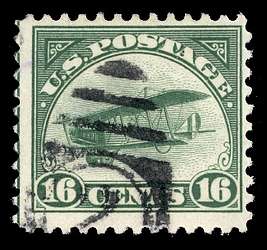 ACTUAL item. |
--- | --- |
18.00 |
||
| 242986 |
Scott #C3 [1918 24c carmine rose and blue Jenny Biplane] NEVER HINGED stamp with Average centering. Left sheet margin example, showing bottom half of the arrow, and with the guideline fully in the upper margin of the stamp, from row 6. Note that to show the line fully on the stamp, the stamp has to be centered low as this one is. Lightly hinged only in the sheet margin; stamp is NH. For plane position collectors, this example shows the plane perfectly centered. Brilliant color and wonderfully fresh. The first three airmail stamps, Scott #C1-3, were printed in sheets of 100 and were available at post offices in panes of 100. The plate layout is unusual (and different from C4-6). There is only a single plate number for the sheet, located above column 7; there is no plate number in the left margin. The top and left have perforated sheet margins. The right and bottom margins are not perforated; they have natural straight-edges usually very closely cut to the design of the stamps (no additional sheet margin). There is a vertical guideline between columns 5 and 6 and a horizontal guideline between rows 5 and 6. The guidelines terminate in a marginal arrow at the top and left side. Straight-edge positions quantities: 9 stamps out of every 100-pane had the natural straight edge only on the right; another 9 only on the bottom and 1 bottom right corner position. Guideline position stamps, depending upon their centering (location of perforations), may or may not share guidelines with the adjacent stamp. Intersection guideline examples (i.e. from a cross-line block) are seldom seen now. Examples with guidelines and especially examples with straight-edges, seem to be scarce, likely due to such stamps either being reperforated or, especially in the case of straight-edge stamps, not being saved by collectors at the time of issue. Examples with straight-edges or guidelines of this stamp were often discarded by early collectors before their significance and relative scarcity was understood. I think that collecting the guideline and straight-edge positions is quite challenging and rewarding. (Scott 2024 $130 for normal NH VF single; this position piece is scarcer.)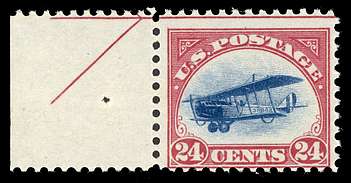 ACTUAL item. |
55.00 |
--- | --- | ||
| 243680 |
Scott #C3 [1918 24c carmine rose and blue Jenny Biplane] Mint with F-VF centering, but with hinge remnant and disturbed gum. Bottom AND Right guideline example from postion 45 in the pane; the 5th horizontal row and 5th vertical column of stamps in the sheet/pane. The first three airmail stamps, Scott #C1-3, were printed in sheets of 100 and were available at post offices in panes of 100. The plate layout is unusual (and different from C4-6). There is only a single plate number for the sheet, located above column 7; there is no plate number in the left margin. The top and left have perforated sheet margins. The right and bottom margins are not perforated; they have natural straight-edges usually very closely cut to the design of the stamps (no additional sheet margin). There is a vertical guideline between columns 5 and 6 and a horizontal guideline between rows 5 and 6. The guidelines terminate in a marginal arrow at the top and left side. Straight-edge positions quantities: 9 stamps out of every 100-pane had the natural straight edge only on the right; another 9 only on the bottom; and 1 bottom right corner position. Guideline position stamps, depending upon their centering (location of perforations), may or may not share guidelines with the adjacent stamp. Intersection guideline examples (i.e. from a cross-line block) are seldom seen now; this position only originally occurred once per 100 stamps, but is much scarcer now.. Examples with guidelines and especially examples with straight-edges, seem to be scarce, likely due to such stamps either being reperforated or, especially in the case of straight-edge stamps, not being saved by collectors at the time of issue. Examples with straight-edges or guidelines of this stamp were often discarded by early collectors before their significance and relative scarcity was understood. I think that collecting the guideline and straight-edge positions is quite challenging and rewarding. (Scott 2025 value $65 for a normal, more common, example.)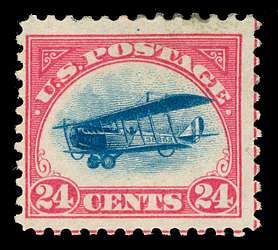 ACTUAL item. |
--- |
32.00 |
--- | ||
| 243708 |
Scott #C4 [1923 8c green Jenny Propeller] Used with F-VF centering with bold #5 "killer" cancellation. Left straight-edge example from the left column of right pane in the printer sheet. (The guideline is not visible on this example.) The plate layout of Scott #C4-6 is different from C1-3. C4-6 were printed in sheets of 400 which were divided by cutting into panes of 100 for sale in post offices. (C1-3, were printed in sheets of 100.) Each of the four panes has a plate number in both the horizontal pane margin and in the vertical pane margin. The sheet images I have seen show only a vertical guideline line, terminated by a marginal arrow in the pane margin (either at the top or bottom, whichever margin is present) between the two left panes and the two right panes. (I would like to know if horizontal guidelines exist.) The panes were divided by cutting; the resulting natural straight edges are usually very closely cut to the design of the stamps (no additional sheet margin). Straight-edge positions quantities: 18 stamps out of every 100-pane had the natural straight edge only on the right; another 18 only on the left; plus the four corner positions where the panes intersect. Guideline position stamps, depending upon their centering (location of perforations), may or may not share guidelines with the adjacent stamp. Examples with guidelines and especially examples with straight-edges, seem to be scarce, likely due to such stamps either being reperforated or, especially in the case of straight-edge stamps, not being saved by collectors at the time of issue. Examples with straight-edges or guidelines of this stamp were often discarded by early collectors before their significance and relative scarcity was understood. I think that collecting the guideline and straight-edge positions is quite challenging and rewarding. An attractive example of a position that is surprisingly seldom offered. (Scott 2025 value is $15 for a more common normal position.)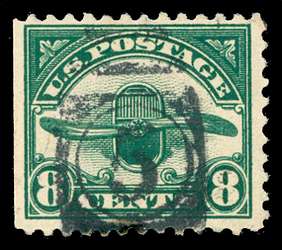 ACTUAL item. |
--- | --- |
9.00 |
||
| 265069 |
Scott #C14 [1930 $1.30 brown Graf Zeppelin] Used with VF-XF centering and neat (LAKE)HURST, (NJ) duplex cancellation. Of course Lakehurst is where the Hindenburg crashed and burned. Right interior margin example, with guideline at right, from the right-most column of one of the two left panes of 50 from the printer sheet of 200. This issue was printed in sheets of 200, which were divided into panes of 50 (5 rows x 10 columns), separated by tearing (not cutting) along the perforations (thus no straight edges) vertically (right and left guidelines) and horizontally (bottom and top guidelines). All the guidelines terminate with an arrow in the outer edge margin of the printer sheet. Up to 40 stamps out of every 200 stamps (up to 20%) originally had a guideline at left and/or right and up to 20 stamps out of every 200 stamps (up to 10%) originally had a guideline at bottom and/or top; the guideline may only show on one or the other of those stamps, or may show on the perforation tips of both. Examples with the guideline fully in the margin of one stamp (and thus not showing on the perforation tips of the adjacent stamp of the next pane) are more desireable, even though, by definition, they are poorly centered, and are fairly unusual in this issue. Examples showing the intersection of the vertical and horizontal guidelines, which can exist in four positions out of 200 in the printer sheet, are particularly hard to find. Guidelines are surprising hard to find on the Zeppelin stamps because many of those that survived have since been reperforated to remove the guideline to "improve" their appearance. (Also, because the guideline edge was also the edge of the pane, sometimes the guideline perforations have become blunted or damaged.) I believe that collecting such stamps (which have become scarce over time due to being reperforated) could be a challenging and enjoyable endeavor. Remarkably well centered example. (Scott 2025 graded value for VF-XF centering is $425, not taking into account the greater scarcity of a guideline example.)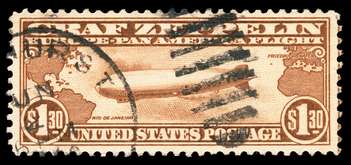 ACTUAL item. |
--- | --- |
369.00 |
||
| 240491 |
Scott #CE2 [1936 16c red and blue Airmail Special Delivery] Mint (one small LH at center of block) F-VF BOTTOM CENTER LINE / ARROW BLOCK OF FOUR. This is TYPE 4 with, in addition to the center red line and arrow, thick short red and blue lines; however, due to misregistration of the blue, the thick blue line is 3 mm to the right. Wonderfully fresh and attractive. While has a very modest catalog value, such nice looking examples are not often offered.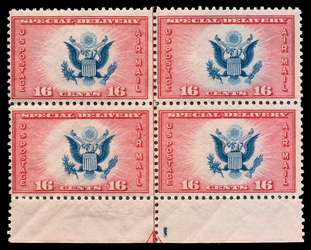 ACTUAL item. |
--- |
4.00 |
--- |